PROVIDENCE TIMELINE
1945 (March 16): Jung Myung Seok was born in Seokmak-ri, Jinsan-myun, Kumsan-gun, South Chungcheong (Chungnam) Province, South Korea.
1951: At age six, Jung discovered Christianity.
1965: Jung served as Sunday school teacher in the local Presbyterian church and became an independent street evangelist.
1966 (February 22): Jung was enlisted to serve in the Vietnam War as part of South Korean Army’s 9th Division.
1967 (August 26): Jung concluded his first tour of duty in Vietnam.
1968 (February 18): Jung returned to Vietnam.
1969 (April 15): Jung concluded his second tour of duty in Vietnam.
1971 (July 20): The rebuilt Presbyterian Seokmak Church was inaugurated in Seokmak, as a result of Jung’s efforts to collect money for the building.
1972–1975: Jung explored several mainline and new religions, including Yongmunsan Kidowŏn and the Unification Church.
1978 (June 1): Jung moved to Seoul.
1982 (March): Jung founded the MS Gospel Association (later called Christian Gospel Mission and popularly known as Providence).
1983: Jung graduated at The Methodist Wesley Theological Seminary.
1987 (January): Jung opened his first church outside South Korea, in Los Angeles.
1988 (January): Jung established his first church in Taiwan.
1989 (July): Jung started the construction of the “natural temple,” Wolmyeongdong, in Seokmak.
1999: Campaign by anti-cult organizations and hostile media against Providence in South Korea.
1999: Jung started a world tour, and launched overseas missions and cultural events in different continents.
2007 (May 1): Following a request by South Korean authorities, Jung was arrested in Anshan, China.
2008 (February): Jung went back to South Korea.
2008 (August 12): The Seoul Central District Court sentenced Jung to six years in jail on three counts of rape.
2009 (February 10): The Seoul High Court overturned the part of the first-degree decision that had recognized Jung not guilty of a fourth count of rape, and sentenced Jung to a total of ten years in jail.
2009 (September 24): The South Korean Supreme Court upheld the Seoul High Court verdict.
2018 (February 18): Jung was released from jail, and resumed his duties as leader of Providence.
2022 (October 4): Jung was arrested again, following accusations of sexual abuse by two non-Korean women and one Korean woman.”
2023 (March 3): Netflix launched the miniseries In the Name of God: A Holy Betrayal, exposing Jung and other Korean “cult” leaders.
2023 (April 18): Female Pastor Jung Jo-Eun was arrested and charged as Jung’s accomplice in the sexual abuse case.
2023 (October 20): Female Pastor Jung Jo-Eun was sentenced to seven years in jail.
2023 (December 22): The Daejeon District Court sentenced Jung to twenty-three years in jail.
FOUNDER/GROUP HISTORY
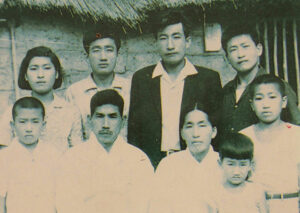
Jung Myung Seok (also transliterated as Jeong Myeong-seok) was born in Seokmak-ri, Jinsan-myun, Kumsan-gun, South Chungcheong (Chungnam) Province, South Korea on March 16, 1945. He was the third of seven children of a couple of impoverished farmers. [Image at right] His parents were only able to support his education in a primary school, after which he had to help with the family farm (Akimoto 2019; two interviews with Jung conducted in Wolmyeongdong in March 19, 2019 and June 5, 2019).
At age six, he first encountered Christianity through missionaries in Seokmak. He reports that he became interested in the Bible and, despite his poor education, read it in its entirety several times. After several mystical experiences, at age twenty, in 1965, while attending a local Presbyterian Church where he also served as Sunday school teacher. Jung decided to devote his free time to street evangelism. He claims his work was non-denominational, as he urged those he evangelized to join whatever Protestant church might be convenient for them.
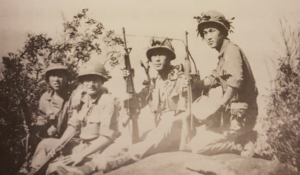
Jung’s life changed dramatically on February 22, 1966, when he was drafted to serve in the South Korean 9th Infantry Division in the Vietnam War. He remained in Vietnam until August 26, 1967, and was called again there for a second tour of duty between February 18, 1968, and April 15, 1969. [Image at right] Critics do not dispute that he served with honor, earning several decorations, including an Order of Military Merit medal. Jung also claims that, during his two Vietnam campaigns, he managed to remain faithful to what he considered the Christian imperative not to kill anybody, not even enemies in war. This claim is supported by testimonies by some of Jung’s comrades in Vietnam (Jeong 2020).
Upon his return from Vietnam, Jung resumed both his farming and evangelistic  activities, and decided to devote a substantial part of his savings and time to rebuilding the Presbyterian church in Seokmak, which was in a destitute state. The new church was inaugurated on July 20, 1971. [Image at right] However, for several years he had harbored doubts on the Presbyterian teachings. He began asking friends to draw diagrams representing his understanding of the Bible, which put him at odds with the Presbyterians. For the better part of the decade of the 1970s, he visited several mainline and new religions, not only Christian, as they included Daesoon Jinrihoe and Won Buddhism (Christian Gospel Mission 2017:95). He explored both mainline Christian denominations, such as the Methodists, Baptists, and Roman Catholics, and new religious movements, including the Jehovah’s Witnesses and Yongmunsan Kidowŏn, established by Na Un-mong (1914–2009). Na had a special influence on Jung, who later regarded him as a “major prophet” (Christian Gospel Mission 2017:103–05). Na had been expelled from the Presbyterian Church for heresy in 1966, although after his death his son led his movement to merge with the Methodists (Encyclopedia of Korean Culture 2014).
activities, and decided to devote a substantial part of his savings and time to rebuilding the Presbyterian church in Seokmak, which was in a destitute state. The new church was inaugurated on July 20, 1971. [Image at right] However, for several years he had harbored doubts on the Presbyterian teachings. He began asking friends to draw diagrams representing his understanding of the Bible, which put him at odds with the Presbyterians. For the better part of the decade of the 1970s, he visited several mainline and new religions, not only Christian, as they included Daesoon Jinrihoe and Won Buddhism (Christian Gospel Mission 2017:95). He explored both mainline Christian denominations, such as the Methodists, Baptists, and Roman Catholics, and new religious movements, including the Jehovah’s Witnesses and Yongmunsan Kidowŏn, established by Na Un-mong (1914–2009). Na had a special influence on Jung, who later regarded him as a “major prophet” (Christian Gospel Mission 2017:103–05). Na had been expelled from the Presbyterian Church for heresy in 1966, although after his death his son led his movement to merge with the Methodists (Encyclopedia of Korean Culture 2014).
In 1973 and 1974, Jung attended a Holiness church in Gwangju, which did not prevent him from exploring other religions and movements. He also read the works of independent Christian theologian Han Enoch (Han Jin-Gyo, 1887–1963), whom he also came to regard as a prophet (Christian Gospel Mission 2017:105–06).
In November 1974, Jung encountered the Unification Church. On March 20, 1975, he was registered as a member of the church founded by Reverend Moon Sun Myung (1920–2012). Jung’s church is often presented as a “schism” of the Unification Church. Jung claims that it was quite easy to be registered as a “member” of Moon’s church in the 1975; to inflate their numbers, they registered as members all those who attended their meetings. Jung, however, admits that he occasionally delivered speeches at Unification Church’s events until 1978, and in an interview with me he compared Moon’s relation with himself to John the Baptist’s with Jesus.
Jung also reports that in 1978, he heard a voice from Heaven telling him, “Do not seek Bethel, do not go to Gilgal.” These are locations mentioned in the Bible, and Jung interpreted Bethel to mean the mainline Protestant churches, and Gilgal to mean the Unification Church. On Ju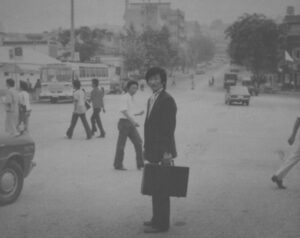 ne 1, 1978, Jung moved to Seoul, determined to launch his own independent ministry. He claims he came to the capital with only the equivalent of US $ 300, but he had his diagrams, and trusted they would attract interest. [Image at right] Through street evangelism, he gathered a handful of followers, who grew to a few hundred and then to a few thousand. In 1982, he established the MS Gospel Association, which was later called Christian Gospel Mission and popularly known as Providence.
ne 1, 1978, Jung moved to Seoul, determined to launch his own independent ministry. He claims he came to the capital with only the equivalent of US $ 300, but he had his diagrams, and trusted they would attract interest. [Image at right] Through street evangelism, he gathered a handful of followers, who grew to a few hundred and then to a few thousand. In 1982, he established the MS Gospel Association, which was later called Christian Gospel Mission and popularly known as Providence.
Jung found some friends among the capital’s Protestant ministers. Despite his limited education, they managed to have him accepted in the Methodist Wesley Theological Seminary, where he obtained a degree in 1983. Jung toured Korean universities, and gathered a sizeable following among college students. Some of them also went to preach abroad, which allowed Providence to 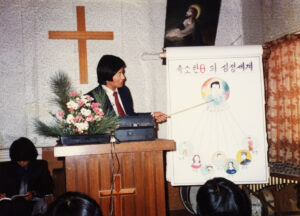 establish its first church abroad in January 1987, [Image at right] in Los Angeles, and in January 1988 the first church in Taiwan. There the movement would grow rapidly, again, mostly among college students. Japan, Australia, and New Zealand are other countries where Providence expanded with some success. In 1989, Jung started realizing his dream of a “natural temple,” (i.e. a temple in the nature without walls but with statues and other sacred artifacts) Wolmyeongdong, built in Jung’s hometown of Seokmak. His followers started calling him “President Jung.”
establish its first church abroad in January 1987, [Image at right] in Los Angeles, and in January 1988 the first church in Taiwan. There the movement would grow rapidly, again, mostly among college students. Japan, Australia, and New Zealand are other countries where Providence expanded with some success. In 1989, Jung started realizing his dream of a “natural temple,” (i.e. a temple in the nature without walls but with statues and other sacred artifacts) Wolmyeongdong, built in Jung’s hometown of Seokmak. His followers started calling him “President Jung.”
In the 1990s, while Providence expanded in South Korea and throughout the world, reaching some seventy countries with tens of thousands of members, it was targeted by the highly active Protestant Korean anti-cult movement (See, Kim 2007) as “heretic.” The presence of thousands of young women (although there were young men too) also raised suspicions. Rumors of “sexual initiations” of young women by Jung started circulating in the late 1980s, and were regarded as believable by ethnologist Nathalie Luca in her 1994 doctoral dissertation (Luca 1994) and 1997 French book Le Salut par le foot (Salvation Through Football), following participant observation in South Korea (Luca 1997; see also Luca 1998, 1999-2000). Luca reported she had not been personally molested, but she believed she might have been had she remained in the country longer rather than returning to France (Luca 1997:20–21). The few members I interviewed who remember Luca claim that it was not clear to them that she was conducting participant observation, and indeed she was registered as a “member” of the church. Not unexpectedly, they also strongly disagree with the conclusions of her book.
While Luca’s book had almost no impact in South Korea, a 1999 exposé by the TV network Seoul Broadcasting System (SBS) put the sexual abuse allegations in the national spotlight. Jung left South Korea to conduct missionary activities abroad for the next seven years, while the media campaigns continued. He was arrested in China in 2007 and was forced to go back to South Korea in 2008; there he was ultimately sentenced to a term of ten years in jail. Released in 2018, on October 4, 2022, Jung was arrested again. On December 22, 2023, he was sentenced to twenty-three years in jail.
Remarkably, during the ten years when Jung was in jail, Providence continued to grow, much to the astonishment of its critics. He continued to lead the movement from jail. Ms. Kim Ji-seon, who went under the name Jung Jo-eun, was appointed as the “representative disciple,” and delivered to the church the messages written by President Jung while he was abroad and, later, in jail, until 2023, when she first disassociated herself from Jung and then was arrested herself.” When he was released, 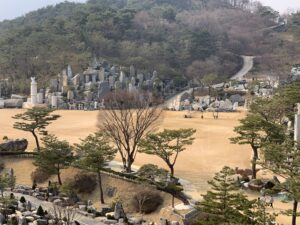 on February 18, 2018, President Jung returned to Wolmyeongdong and was able again to preside over an expanding church. [Image at right] I attended functions in Wolmyeongdong, Seoul, and Taipei, and interviewed several members, as well as reporters and critics. All confirmed that the attendance at Providence’s gatherings did not diminish during and after Jung’s first detention, although after the second conviction of 2023 the church should confront the possibility that its founder will spend the rest of his life in jail.”
on February 18, 2018, President Jung returned to Wolmyeongdong and was able again to preside over an expanding church. [Image at right] I attended functions in Wolmyeongdong, Seoul, and Taipei, and interviewed several members, as well as reporters and critics. All confirmed that the attendance at Providence’s gatherings did not diminish during and after Jung’s first detention, although after the second conviction of 2023 the church should confront the possibility that its founder will spend the rest of his life in jail.”
DOCTRINES/BELIEFS
Critics maintain that Jung’s core teachings (the so-called “Thirty Lessons”) are remarkably similar to the Divine Principle of the Unification Church. The relationship has been constructed as plagiarism, or at least as “a sort of updating of the Unification Church” (Luca 1997:31). Local Korean critics have also accused Jung of “plagiarizing” Na Un-mong or Han Enoch. Jung would say that Moon, Na, and Han all had their own prophetic missions, while announcing his own, although Moon betrayed his mission under the influence of his wife. Although there are similarities among the texts, the general assessment that Jung “plagiarized” Moon or simply “updated” the Divine Principle is questionable. A careful reading of the “Thirty Lessons” shows both similarities and important differences.
The Thirty Lessons are based on the idea that Christianity should conform to reason and science and, when miracles and other events in the Bible appear to violate the laws of nature, they should be interpreted symbolically. Biblical interpretation in Providence is based on four principles: analogy (“the Bible interprets itself”); historical context; double interpretation from the respective points of view of “spirit” and “flesh,” and numerology.
Jung teaches that human beings consist of three components, body, soul, and spirit (a teaching he claims to derive from 1 Thessalonians 5:23), in the image of the Trinity. The mind is not a component of the human being, but is part of the body. There are different soul levels: the physical soul is related to physical body, while the spiritual soul allows connections with spiritual beings and the spiritual world. Animals have a body and a physical soul, but not a spiritual soul nor a spirit, which according to Jung shows that the theory of evolution is false, since spiritual soul and spirit cannot evolve from body. The universe progresses through a law of nature designed by God.
The soul acts as a mediator between body and spirit. When we see ourselves in dreams, we see our “soul body.” There are other spiritual techniques to access the “soul world” outside our dreams, an exercise that is useful, as in the soul world we can discern in a better way our own and other people’s thoughts and, to some extent, predict the future. At death, the body dies but the soul, which includes all the memories, survives, just “as a memory drive [which] is taken out of a computer,” and unites with the spirit (Jeong 2019:I, 21; Personal Interviews 2019).
While we are alive, according to our good or bad deeds, the spirit dwells either in the domain of life or the domain of death; there is also a middle level domain (Jeong 2019:I, 22).
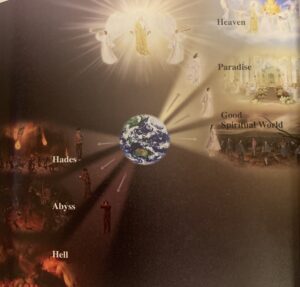
Heaven and Paradise, according to Providence, are not the same. The world is divided in six main levels (although, from a more complex perspective, these levels can in fact be millions): Hell, Abyss, Hades, the Good Spiritual World, Paradise, and Heaven. [Image at right] Heaven in turn is divided in the three levels of servants, children, and brides of God (which also correspond to the Old, New, and Complete Testament). The Good Spiritual World and Hades (also called the Evil Spiritual World) are on earth, all the other levels are destinations for our souls after this life. In almost all cases, where we will go is determined by what we did in life, although in some special circumstances the spirit is able to lift itself up in the spiritual world. Spirits can visit their own and lower levels, but not upper levels. While on earth, we cannot see the spiritual worlds, but we can receive information about them by “becoming spiritual,” understanding the Bible, receiving spiritual dreams, and learning from spirits who come on a mission from Heaven (Jeong 2019:IV:78–83).
God (regarded as male in Providence’s theology) created human beings to be his brides (irrespective of whether they are male or female), and exchange love with him. “God’s purpose of creation is only love” (Jeong 2019:II, 17). Archangel Lucifel (Lucifer) opposed God’s creation of human beings, as he was envious that they would be closer to God than the angels. God could have thrown him into Hell immediately, but instead exiled him to earth, giving Lucifer an opportunity to repent. But he continued to oppose God, and induced Eve to fall. The fruit of the Tree of Good and Evil is the female sexual organ (Jeong 2019:II, 75), and eating it for Eve meant making love with Adam after having been spiritually corrupted by the serpent (Lucifer). Those familiar with the Unification Church would recognize here one of the elements of similarity. The fact that the original sin had a sexual component does not mean that sex is regarded as evil by Providence. What is evil is becoming addicted to sex, or indulging in its practice before having achieved the necessary spiritual maturity.
As a consequence of the Fall, Lucifer became Satan, and Eve, Adam, and their descendants could not become brides of God, only servants. The Trinity could have created human beings as perfect and incapable of sinning. But it did not, because a love for God conquered by overcoming imperfections and temptations is more valuable than a love imposed by God and practiced without effort.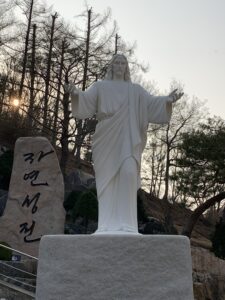
In due time, the Holy Son, through Jesus, opened the path of salvation. We are saved through the mission of the Holy Son, the second person of the Trinity. However, it is a key teaching of Providence that the Holy Son and Jesus “are not the same person” (Jeong 2019:I, 54). [Image at right] The Holy Son is a divine being, with no visible body. He “came upon Jesus” (Jeong 2019:I, 55), a human being, allowing him to become the Messiah. It was the spirit of Jesus, not his body, that resurrected, as the bodies of human beings do not resurrect. After manifesting itself to the disciples, the spirit of Jesus ascended to Heaven, while the Holy Son, having worked through Jesus, sat “on the right hand of God” (1 Peter 3:22). It is thus not Jesus who seats at the right hand of the Father, it is the Holy Son (Jeong 2019:I, 57).
Thanks to Jesus’ mission, humans were able to become children of God rather than servants. But not yet brides of God, a higher position. For humans to become brides of God, the Second Coming was needed. Many Christians believe that Jesus will come back in the Second Coming, but in fact it is not Jesus. The Holy Son works in different times through different human beings, who are persecuted and suffer. Jesus was the “standard of sons.” Now, the “standard of brides” should come (Jeong 2019:III, 20–9). Just as he used Jesus in the First Coming, the Holy Son appears again in the Second Coming by using “a worthy person,” who will assume a key role in the history of salvation, yet remain a human being, “a person of the earth like Jesus of Nazareth” (Jeong 2019:I, 59).
Several Christian denominations also expect the Holy Son physically “coming on the clouds” (Matthew 24:30) at the Second Coming. But in fact, according to Providence the “clouds” are the “cloud of witnesses” of Hebrews 12:1 (i.e. a “cloud” of human beings who will believe in the 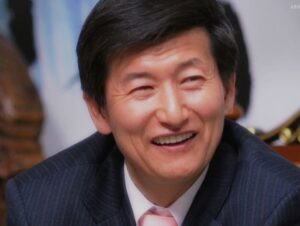 Second Coming). In a miniaturized version, the “cloud” is the “man-of-mission” himself, in a “magnified” version it represents those who believe in his mission. Providence believes that this man-of-mission is President Jung, and we can know and believe this as certain through numerology and logic. [Image at right]
Second Coming). In a miniaturized version, the “cloud” is the “man-of-mission” himself, in a “magnified” version it represents those who believe in his mission. Providence believes that this man-of-mission is President Jung, and we can know and believe this as certain through numerology and logic. [Image at right]
The Trinity works in history through the key numerological principle of “a time, times, and half a time,” which appears twice in Daniel (Daniel 7:25 and 12:7) and once more in Revelation (12:14). It can mean three and a half days, three and a half years (1260 days), or 1260 years according to the principle “one year for one day” of the Adventist tradition (on the history of which, see Froom 1946–1954). This numerology is part of a “miniaturized” version of the principle (Jeong 2019:I, 77). There is also a large-scale version, where the principle is connected with the number forty of Ezekiel 4:6 and Numbers 14:34, and can refer to periods of 40, 400, or 4,000 years (40 for the individuals, 400 for the nations, 4,000 for the world). The 400 years passed four times (1,600 years) between Adam and Noah. Then, there were 400 years between Noah and Abraham and between Joseph and Moses. The Old Testament globally is a period of 4,000 years preparing for Jesus, who came 400 years after Malachi, the last prophet of the Old Testament. The New Testament lasts for half the years of the Old Testament (i.e. 2,000 years), and the man-of-mission in the Complete Testament should come 400 years after Martin Luther (1483–1546), who is regarded by Providence as the last prophet of the New Testament, and in turn came 1,600 years after Jesus (Jeong 2019:I, 79 and III, 89). Since Luther died in 1546, the man-of-mission used by the Holy Son should be born in 1945, which points to Jung and rules out other candidates. Also, 1945 comes at the end of a forty-year period relevant for Korea, the Japanese occupation from 1905 to 1945.
The 1,260-day (or year) period of Daniel 7:25 and 12:7 is also related to the 1,290 days of Daniel 12:11, and the 1,335 days of Daniel 12:12, making Providence’s numerology even more complicated. Only the man-of-mission was able to break the seal and unveil the mystery of Daniel 12:7, which is “God’s heavenly law” and “the clock of history” (Jeong 2019:III,108), and he did it at an appropriate numerological time.
Jung admits that the principle “a time, two times, and half a time” was already discussed by Han Enoch in the 1940s. He stated that, “Han Enoch unraveled half of the secret about ‘a time, two times, and half a time,” which confirms that he was a true prophet. However, Han only disclosed “half of the secret,” as some of his interpretations were wrong (Christian Gospel Mission 2017:105).
Daniel 12:11 also mentions 1,290 days from the “abomination” in the place of the holy sacrifice. For Providence, the “abomination” is the mosque built in Jerusalem where the Temple once stood, in 688 CE, and 688 plus 1,290 makes 1978, which is when Jung started preaching the Word of the Complete Testament. From 1999 to 2012 there were four three-and-a half-year times, “grave periods” for Providence preceding “resurrections.” Providence believes that 1999 was also prophesied by Nostradamus (1503–1566), who is probably more read and well-known in East Asia than he is in Europe or North America, as “a time of the last days” (Jeong 2019:I, 95). All kinds of signs and expectations of the end happened in the world in 2012. From 2013, Providence became completely independent from the New Testament and entered the era of the Complete Testament (Jeong 2017:III, 89).
Numerology, Providence teaches, also attests the connection between Jung’s mission and world peace. 1945, the year Korea was delivered from the Japanese and Jung was born, is also the year the United Nations were founded. In the year when Jung started its peace activities in Europe (1999), the euro as a common European currency was introduced. When he was visiting Italy, Jung claims he was directed by the Holy Son to go and pray in the Cathedral of Milan on October 31, 1999. He came from a Protestant tradition, and did not understand why he should pray in a Catholic Church. However, he later learned that on that day Catholic and Lutheran representatives had signed in Augsburg the Joint Declaration on the Doctrine of Justification (Lutheran World Federation and Catholic Church 1999), a historical step in the reconciliation between Catholics and Protestants (Jeong 2019:I, 96–97).
Numerology offers one proof that Jung is the man-of-mission for the Complete Testament. His life and ministry, Providence teaches, provide additional evidence. Jung acquired his position gradually by totally reciprocating the Holy Son’s love, becoming the bride of the Holy Son, and preaching to thousands who would also become brides of God (no matter whether they are female or male).
A part of Protestant Christians believes in the Rapture (i.e. in the theory that at some stage in the Last Times faithful believers will be “raptured” to be with Christ in Heaven). According to some interpretation of the Rapture, they will thus be spared the apocalyptic disasters predicted in the Book of Revelation, while others believe the Rapture will happen after these disasters. Providence has a different theory of the Rapture. It teaches it is a spiritual event, not an event of the flesh, and it already happened, on March 16, 2015.
Although in 2015 Jung was in jail, Providence believes that crucial spiritual events happened at that date. Jung turned seventy, and 6,000 years from the beginning of salvation history were completed. March 16 (3/16), besides being Jung’s birthday (or perhaps because of this), has a numerological significance, three representing the Trinity, one Pastor Jung, and six a “miniaturized version” of 6,000 years, but ultimately the date of the Rapture was decided by God. At that date, the Holy Son ascended to his present position in Heaven (Jeong 2019:III, 72–73).
From that date, March 16, 2015, “a time, two times, and half a time,” (i.e. 3-and-a-half years started), where those raptured were able to raise their level). The three-and-a half-years before March 16, 2015 were also important, as Providence members were called to remain loyal to their jailed leader and follow his instructions. Those who failed to do so were not raptured (Jeong 2019:IV, 118), although as long as Jung is alive there are still possibilities to join the Rapture. More precisely, Rapture means entering the Golden City of Heaven. There are four conditions for this: to defeat Satan by obeying God’s word; defeat those who slander Providence; succeed where Adam and Eve failed by loving God unconditionally, and not falling sexually in the body; believe absolutely in the Savior sent by God (i.e. Jung). Like the resurrection of Jesus, the rapture is spiritual. Bodies are not involved. But the spirits become beautiful (Jeong 2019:III, 60).
After March 16, 2015, Satan, who was further enraged by the Rapture, has tried to interfere acting through human bodies and causing suffering to those raptured, to falsely persuade them that “they have not raptured.” Some fall, others manage to defeat Satan.
Providence believes in the Trinity, but teaches it consists of three “separate entities.” While the Holy Son is male, the Holy Spirit is female, and is also known as Mother God. Pastor Kim Ji-seon, who later went under the name Jung Jo-eun, was identified as “the symbolic entity of the Holy Spirit,” who is female (Jeong 2019:IV, 39), and in 2009 assumed the role of “revival preacher for the Holy Spirit.” Pastor Jung Jo-eun, according to Providence, assumed her mission related to the Holy Spirit because of her great efforts aimed at testifying God’s words in the new era, comparable to the Apostles’ efforts after they received the Holy Spirit at Pentecost. Providence also explains that her relationship with Jung is a purely spiritual one. She vowed to live in lifelong chastity, as is the case in general for Providence clergy.
In 2023, Pastor Jung Jo-Eun publicly criticized Jung’s behavior in March and was arrested in April and charged as Jung’s accomplice in the sexual abuse cases. However, Jung instructed his disciples from jail that they should not criticize Pastor Jung Jo-Eun nor comment on her situation and statements (personal interviews, Taipei, July 31, 2023).
RITUALS/PRACTICES
As other observers have noted since the early days of the movement (Luca 1997:28), the worship services of Providence are rich but somewhat informal. College students and others attend Bible studies or clubs, where they read Jung’s messages, study the lessons, and discuss lively between themselves. Services (some of which I attended) featuring President Jung in Wolmyeongdong include a sermon by him him (in person when he was free, replaced by a video of one of his old sermons since he was arrested), speeches by other ministers, and a 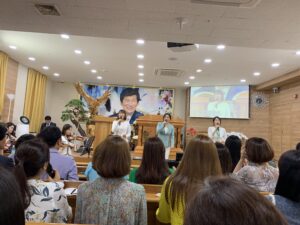 significant amount of music. The sermons revolve around Providence’s interpretation of the Bible and expositions of its theology, as presented in the Thirty Lessons. [Image at right]
significant amount of music. The sermons revolve around Providence’s interpretation of the Bible and expositions of its theology, as presented in the Thirty Lessons. [Image at right]
Providence recommends that members intermarry with other members and organizes “networking events” where male and female members, including from different regions or countries, can meet each other and eventually decide to date and marry. Providence reports that the divorce rate in these endogamous marriages is less than one percent.
ORGANIZATION/LEADERSHIP
Providence does not release statistics, but acknowledges its membership is in the tens of thousands, and this is accepted even by critics. Perhaps 100,000 is a reliable figure, if all groups outside South Korea are included.
President Jung is the undisputed leader of the church, and he has continued in his position even during detention. He is assisted by a group of senior pastors
The formal name of the church is Christian Gospel Mission. Like “Mormon” for the Church of Jesus Christ of Latter-day Saints, or “Quakers” for the Society of Friends, “Providence” was initially used mostly by critics, but is now a common designation of the movement. The church is, or was in its earlier years, sometimes also known as “Jesus Morning Star” (JMS). The same letters JMS are the full initials of President Jung (Jung Myung Seok).
Each country where Providence is present in significant numbers has an 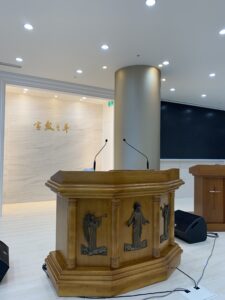 autonomously incorporated organization, although an international missionary center at the South Korean headquarters coordinates all of them. The two largest foreign organizations, in Japan and Taiwan, enjoy considerable autonomy. [Image at right]
autonomously incorporated organization, although an international missionary center at the South Korean headquarters coordinates all of them. The two largest foreign organizations, in Japan and Taiwan, enjoy considerable autonomy. [Image at right]
Local churches are led by one or more pastors, who can be male or female. There are seminars preparing pastors in different countries, including South Korea, Taiwan, and Japan.
Some members decide to remain celibate, to be able to devote more time to the church. They are called “stars of faith,” and appear to be at the origin of the media rumors about the so-called “Evergreen,” described as young female members who vow to have sexual relations with President Jung only. According to Providence, the claim is totally fantastic, the nickname “Evergreen” was never officially used for celibate members, and the “stars of faith” are both male and female.
Among the ancillary activities, Providence has a sport department. It does organize soccer events, including the National Peace Tournament in 2017, but it also promotes baseball, softball, volleyball, and basketball. The insistence is on team sports, as they teach team spirit and are seen as a metaphor of Christian cooperative life.
An Arts Group includes departments devoted to the visual arts, music, dance, design, and fashion. President Jung himself is an accomplished painter, and exhibitions of his work took place in various countries, including during his detention. Taiwan’s Peace Symphony Orchestra, established in 2013, has 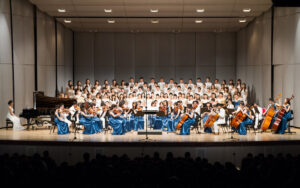 performed in several countries and is regarded as the most professional outcome of the movement’s love for music. [Image at right]
performed in several countries and is regarded as the most professional outcome of the movement’s love for music. [Image at right]
The Christian Gospel Mission Volunteer Group performs public services, such as the ecological cleaning of mountains and beaches, and assists the poor and the elderly (not only if they belong to Providence). Given the number of high school and college students in the movement, the Volunteer Group also offers services of school and career orientation.
ISSUES/CHALLENGES
Although the main accusations against Providence concern sexual abuse, Providence has also been accused of dissimulation in its proselytization. The sexual abuse cases are examined here is some detail to demonstrate their complexity, the importance of social and cultural factors shaping the way that such cases transpire, and their impact on movement functioning and development.
The first criticism is commonly directed against many if not most Korean Christian new religions. Like other groups, Providence uses a variety of different names. While they may reflect different organizational models in different countries where the movement is active, there is little doubt that the name “Providence” is often avoided because of its media notoriety after the sexual abuse charges. As it happens with other Korean movements, this perpetuates a vicious circle. The more Providence is attacked in the media, the more it tends to use other names when first inviting potential converts to its activities, which in turn results in more media criticism against its dissimulation strategies.
While thousands of college students are familiar with Providence, mostly because of its student clubs and on-campus activities, the public opinion in South Korea and some other countries only knows the movement because of the high-profile trial of President Jung and his sentencing on charges of sexual abuse.
After the media campaigns of 1999, Jung left South Korea for his world tour, but his adversaries pursued him abroad, and he was also investigated in other countries such as Japan, Hong Kong, and Taiwan. An anti-cult organization called Exodus was formed to actively oppose Providence, and organized press conferences in South Korea and abroad, where masked women appeared and told how they had been molested by Jung. On May 1, 2007, following a request by South Korean authorities, Jung was arrested in Anshan, China. He returned to South Korea in February 2008. According to his lawyers, he complied voluntarily with a summons by the South Korean authorities rather than complying with a formal extradition by China.
On August 12, 2008, the Seoul Central District Court sentenced Jung to six years in jail on three counts of rape. He was also sentenced for embezzling money belonging to the movement, although the distinction between the funds of Providence and the private funds of Jung was not easy to establish. On February 10, 2009, the Seoul High Court overturned the part of the first-degree decision that had recognized Jung not guilty of a fourth count of rape, and sentenced Jung to a total of ten years in jail. On September 24, 2009, the South Korean Supreme Court upheld the Seoul High Court verdict and Jung remained in jail, until February 18, 2018, when he ended serving his term. In 2020, after two other (non-Korean) women had complained of sexual abuse in a press conference organized by Providence’s opponents, an investigation was started and on October 4, 2022, Jung was arrested again.
Events that happened in 2023 created new problems for Providence. On March 3, Netflix launched in several countries and languages an anti-cult miniseries called In the Name of God: A Holy Betrayal, exposing Jung and other Korean “cult” leaders (Netflix 2023). Providence’s request for a preliminary injunction stopping the broadcast of the series was rejected (Frater 2023). The series was extremely successful and its indictment of Jung as a sexual predator led to a new raid in Wolmyeongdong by the police and a statement against Jung by South Korea’s Prosecutor General (UCANews 2023), as well as personal problems for Providence devotees who lost their jobs in several countries when the fact that they were members of the church was disclosed by anti-cultists on social media (personal interviews, Taipei, April 11 and July 31, 2023, and Sydney, April 18, 2023).
Much more than the legal cases themselves, the Netflix series led to defections from the church. According to Korean media, tabloids, and anti-cult websites the “representative disciple” Jung Jo-eun tried to distance herself from Jung and there were rumors that she was establishing a splinter group (Koreaboo.com 2023). However, as mentioned earlier, on April 18 she was arrested herself as Jung’s alleged accomplice in the sexual abuse cases (Churchheresy.com 2023).
On October 20, 2023, she was sentenced to seven years in jail for aiding and abetting Jung when he committed his sexual crimes. Jung himself was sentenced to twenty-three years in jail on December 22, 2023 for having sexually assaulted two non-Korean women (one of whom was prominently featured in the Netflix series) and one Korean woman. His lawyers appealed, while the prosecutors stated that they may further prosecute Jung for some twenty additional cases of sexual assault, based on women who largely filed charges or testified after the Netflix series was aired. Meanwhile, Netflix announced it was preparing a second season of the series with further testimonies against Jung. Demonstrating the power of the media, the 2023 Netflix series set in motion a series of events that make the future of Providence much more uncertain than it appeared when, before March 2023, the church was showing a remarkable resilience notwithstanding its leader’s imprisonment.
There are three irreconcilable narratives about the charges of sexual abuse. The court’s narrative concerning the first case was that four South Korean women were sexually molested by Jung in countries other than South Korea after 1999. The decision did not take a position on whether or not “sexual initiations” were practiced within Providence, but regarded the women as believable, and the context of a “cult” where members were “psychologically manipulated” by the leader reinforced the judges’ opinion. About the second case, the court dismissed the defense objection that, if they happened, relationships were consensual by using the argument that the victims were “first brainwashed into thinking that Jung was the Messiah,” then sexually abused while they had been put in a psychological situation where refusing a request by their leader was unthinkable.”
It is important to note that the Korean Criminal Act distinguishes between three different crimes, rape (Section 297), sexual assault (Section 298), and “quasi-rape” and “quasi-sexual-assault” (Section 299). The latter section refers to cases where the perpetrator takes advantage of the victim’s “condition of unconsciousness or inability to resist.” In Jung’s first case, all victims (which are designated here with letters to preserve privacy) were Korean women. A and B claimed to have been molested in Hong Kong, C and D in Anshan City, China, and E in Malaysia. In the case of A and B, Jung was found innocent of rape, as the court did not believe there had been violence or intimidation, but guilty of “sexual assault” in the form of unsolicited “indecent touching,” and of “quasi rape” because, although not physically coerced or threatened, A and B psychologically were “in a state of inability to resist.”
C eventually became a main public voice for the anti-cult association Exodus. D eventually withdrew her accusations, saying she had been coached by C to lie. C was a forceful accuser at trial, and the judges believed her claim that she had been physically raped while taking a shower. The defense argued that C was a martial arts champion, and could have easily resisted a sixty-one-year-old man, but her testimony stood.
In the case of E, the judges of the lower court found Jung innocent of all charges, concluding that from E’s own account no violence or threat had emerged. The appeal court, however, reversed that decision and argued that, since E “thought that Jung was Jesus” she was in a status of psychological “inability to resist,” and Jung was found guilty of “quasi-sexual-assault.”
The defense also argued that the accusers had participated in “camps” organized by Exodus, where they had been indoctrinated by the anti-cultists. This was regarded as true but not relevant by the first degree and appellate courts. Indeed, the question whether a woman who believes that her male spiritual leader has a special divine mission is, for this reason, in a condition of “inability to resist” sexual advances by him, has been frequently discussed in “cult” cases. The positive answer involves accusations of brainwashing and mind control, which would allow the conclusion that a “quasi-sexual-abuse” occurred even in a consensual event, where the consensus was allegedly created through mental manipulation. According to the court, this was the case for A, B, and (in the appellate case) E, while C successfully alleged full-blown rape.
In the second case decided in 2023, the victims were two non-Korean women and a Korean woman. Jung was sentenced again for quasi-rape and sexual molestation. The defense appealed, noting that even by considering Jung’s recidivism, a jail penalty of twenty-three years is an unusually harsh punishment for quasi-rape. They also lamented a “Netflix effect” that might have influenced the verdict. The appeal will also explore, once again, the notion of “quasi-rape,” which is strictly connected to theories of “brainwashing,” a term explicitly used in the 2023 decision to indicate techniques allegedly used by Jung and Providence to induce women to consent to sexual relationships they only accepted because they believed Jung was the Messiah and his requests, including those of a sexual nature, cannot be denied.
There is a second narrative, common in South Korean and other media, claiming that the cases for which Jung was sentenced were just the tip of the iceberg, and in fact “sexual initiations” for women disciples were common and might have involved thousands of them. Nathalie Luca also regarded these accusations as believable (Luca 1997). Apart from the legal qualification of what allegedly happened in these initiations as consensual or otherwise, in several cases South Korean courts found these accusations excessive, including when Jung was serving his term in jail. Providence won lawsuits against different Korean media, as courts allowed details of the trial to be published but still regarded generalizations and allegations about hundreds or thousands of alleged sexual abuse cases as defamatory. They also found that, in some cases, media had doctored photographs and audio recordings of Jung to make them appear more sinister or incriminating than they in fact were. Some journalists and media had to publish apologies (Christian Gospel Mission 2017 discusses these cases at length).
The third narrative, which is passionately believed by members of Providence, is that a cabal of slanderers and anti-cultists created the whole legend of the “sexual initiations,” and that these never happened. Later, this narrative goes, the anti-cultists found some vindictive ex-members and women whose main purpose was to extract money from Jung, which led to the trial and the convictions. This occurred, they argued, in a South Korean cultural climate where someone branded by the media 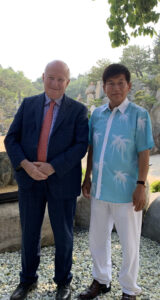 and the powerful mainline churches as a “cult leader” could not expect to be treated fairly by the judges. Jung himself has always denied all charges. [Image at right]
and the powerful mainline churches as a “cult leader” could not expect to be treated fairly by the judges. Jung himself has always denied all charges. [Image at right]
In addition to the factors discussed above, several others complicate any final resolution One is that several Korean groups actually did practice sexual initiation at some point in their histories. Most, if not all, Korean Christian new religious movements come from a common matrix, the so-called “Jesus Churches,” a cluster of Christian Korean new religious movements including the Holy Lord Church, the “Inside Belly Church” (Bokjunggyo), the Israel Monastery, and the Wilderness Church. These movements became notorious for their practice of p’ikareun, a “blood exchange” between the leader and the followers involving, at least in some cases, sexual intercourse (Choe 1993:140–45; Chryssides 1991:91–103). Both Reverend Moon and Elder Park Tae Son (1917–1990), the founder of the Olive Tree movement, which is at the origin of a whole lineage of Korean Christian new religions, had contacts with the Jesus Churches, and were accused of practicing p’ikareun. What was practiced, or not practiced, in each movement is a matter of controversy, but because of these precedents it became commonplace for Korean anti-cultists and mainline churches to accuse all “heretic” movements of performing “sexual initiations.”
A second is demographics. Providence’s membership consists mostly of college students. There is a majority of female students, although a good forty percent consists of males. The women are indistinguishable in their dressing style from the average college student in their respective countries, a style that is far away from the conservative habits of most mainline South Korean Protestant churches. What would be regarded as normal at a college party may easily appear as scandalous to conservative South Korean Protestants. Further, there is an inclination within the female membership to express physical beauty since Providence doctrine teaches that external beauty is a metaphor and a symbol of internal beauty.
What makes this history of sexual impropriety allegations significant is that Providence in certain respects mirrors the histories of other new movements and examination of this case is helpful in identifying factors that complicate a clear, accurate rendering of events. In this case, there are simultaneous passionate allegations by former members and equally passionate denials by current members, a religious culture history in which the kinds of allegations brought in this case have been documented for other groups with a common historical lineage, specific legal categories that shape the process through which charges can be brought and through which they are adjudicated, court decisions favorable to both sides, and sensationalized media coverage. In what is clearly is a high stakes conflict for parties on both sides of the dispute, the absence of factual clarity leaves enormous latitude on both sides and leaves ample room for instability and volatility. The larger lesson for scholars studying religion is that this is not only the history of Providence, it parallels the histories of numerous other contemporary religious movements and their developmental trajectories.
IMAGES
Image #1: Jung (standing, second from the left), with parents and siblings. Courtesy of Christian Gospel Mission.
Image #2: Jung (second from the left) in Vietnam, March 1968. Courtesy of Christian Gospel Mission.
Image #3: The reconstructed Seokmak church, 1971. Courtesy of Christian Gospel Mission.
Image #4: Jung upon his arrival in Seoul, 1978. Courtesy of Christian Gospel Mission.
Image #5: Jung in the early days of the MS Gospel Association. Courtesy of Christian Gospel Mission.
Image #6: The natural temple of Wolmyeongdong. Photo by Massimo Introvigne.
Image #7: The spiritual world according to Providence. Courtesy of Christian Gospel Mission.
Image #8: Statue of the Holy Son manifested as Jesus, Wolmyeongdong. Photo by Massimo Introvigne.
Image #9: President Jung, the man-of-mission. Courtesy of Christian Gospel Mission.
.Image #10: Worship service in Wolmyeongdong. Photo by Massimo Introvigne.
Image #11: Inside a Providence church in Taipei, Taiwan. Photo by Massimo Introvigne.
Image #12: Peace Symphony Orchestra. Courtesy of Christian Gospel Mission, Taiwan.
Image #13: The author with President Jung while conducting fieldwork, Wolmyeongdong, June 5, 2019. © Massimo Introvigne, 2019.
REFERENCES
Akimoto, Ayano. 2019. 命の道を行く 鄭明析氏の歩んだ道 (Going the Way of Life: The Path of Mr. Jung Myung Seok). Tokyo: Parade.
Choe Yoong-Jun. 1993. “The Korean War and Messianic Groups: Two Cases in Contrast,” Ph.D. Dissertation, Syracuse University.
Christian Gospel Mission. 2017. Handbook for Defence Against Slander. Wolmyeongdong, Seokmak: Christian Gospel Mission.
Chryssides, George. 1991. The Advent of Sun Myung Moon: The Origins, Beliefs and Practices of the Unification Church. New York: St. Martin’s Press.
Encyclopedia of Korean Culture. 2014. “용문산기도원” (Yongmunsan Retreat Center). Accessed from http://encykorea.aks.ac.kr/Contents/Item/E0076655 on 12 August 2020.
Frater, Patrick. 2023. “Sex Cult Expose: Netflix Defeats Injunction, Airs ‘In the Name of God: A Holy Betrayal’ Documentary on Korean Religious Leaders.” Variety. March 3. Accessed from https://variety.com/2023/tv/news/korea-religious-cult-netflix-in-the-name-of-god-a-holy-betrayal-documentary-1235541909/ on 29 August 2023.
Froom, LeRoy Edwin. 1946–1954. The Prophetic Faith of Our Fathers: The Historical Development of Prophetic Interpretation. Washington DC and Hagerstown, MD: Review and Herald.
Jeong, Myeong-seok [Jung, Myung Seok]. 2020. War Was Cruel: Love and Peace in the Vietnam War, 1966-1969. Artesia, California: Evergreen.
Jeong, Myeong-seok [Jung, Myung Seok]. 2019. Read and Preach. Edited by Jeong [Jung] Jo-eun. Four Volumes. Seoul: Youngil Publishing.
Jung, Myung Seok. 2020b. “Sunday Proverbs for February 2, 2020: Be Careful on Your Own.” English translation, Archives of Christian Gospel Mission, Wolmyeongdong, Seokmak.
Jung, Myung Seok. 2020a. “Sunday Message for January 12, 2020.” English translation, Achives of Christian Gospel Mission, Wolmyeongdong, Seokmak.
Jung, Myung Seok. 2014. “Sunday Message for March 9, 2014.” English translation, Archives of Christian Gospel Mission, Wolmyeongdong, Seokmak.
Kim Chang Han. 2007. “Towards an Understanding of Korean Protestantism: The Formation of Christian-Oriented Sects, Cults, and Anti-Cult Movements in Contemporary Korea.” Ph.D. Dissertation, University of Calgary.
Koreaboo.com. 2023. “Who Is She? JMS Cult’s Second-In-Command Leader May Be Just as Dangerous as Jeong Myeong Seok.” Koreaboo.com, March 15. Accessed from https://www.koreaboo.com/news/jms-cult-second-in-command-leader-may-just-dangerous-jeong-myeong-seok-jeong-jo-eun/ on 29 August 2023.
Luca, Nathalie. 1999–2000. “Jouer au football pour fêter Dieu. Le culte d’une Église messianique coréenne.” Études mongoles et sibériennes 30–31:405–29.
Luca, Nathalie. 1998. “Le salut par le foot ou le football rattrapé par les sectes.” Sociétés & représentations 7:213–25.
Luca, Nathalie. 1997. Le Salut par le foot. Une ethnologue chez un messie coréen. Geneva: Labor et Fides.
Luca, Nathalie. 1994. “L’Église de la providence: un mouvement messianique à visées internationales.” Ph.D. Dissertation, Université Paris X.
Lutheran World Federation and Catholic Church. 1999. “Joint Declaration on the Doctrine of Justification.” Accessed from https://www.vatican.va/roman_curia/pontifical_councils/chrstuni/documents/rc_pc_chrstuni_doc_31101999_cath-luth-joint-declaration_en.html on 17 August 2020.
Netflix. 2023. In the Name of God: A Holy Betrayal. Tv miniseries directed by Jo Seong-Hyeon. 8 episodes.
Personal Interviews. 2019. Interviews were conducted by the author with members of Providence, and Jung himself, in South Korea and Taiwan. In addition, access was provided to material in the church’s archives in Wolmyeongdong, including texts such as Christian Gospel Mission 2017 that are normally reserved for members only.
UCANews. 2023. “Police Raid Korean Christian Cult in Sex Crime Probe.” UCANews, March 24. Accessed from https://www.ucanews.com/news/police-raid-korean-christian-cult-in-sex-crime-probe/100779 on 29 August 2023.
Publication Date:
11 October 2020
Update:
31 August 2023
